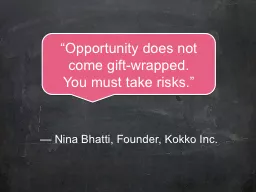PPT-— Nina Bhatti, Founder, Kokko Inc.
Author : danika-pritchard | Published Date : 2018-02-19
Opportunity does not come giftwrapped You must take risks Lead From Where You Are Transitioning from Doing to Leading You have probably built success as a specialist
Presentation Embed Code
Download Presentation
Download Presentation The PPT/PDF document "— Nina Bhatti, Founder, Kokko Inc." is the property of its rightful owner. Permission is granted to download and print the materials on this website for personal, non-commercial use only, and to display it on your personal computer provided you do not modify the materials and that you retain all copyright notices contained in the materials. By downloading content from our website, you accept the terms of this agreement.
— Nina Bhatti, Founder, Kokko Inc.: Transcript
Download Rules Of Document
"— Nina Bhatti, Founder, Kokko Inc."The content belongs to its owner. You may download and print it for personal use, without modification, and keep all copyright notices. By downloading, you agree to these terms.
Related Documents














